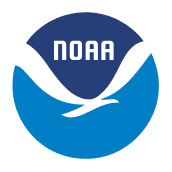Supporting atmospheric observing networks and weather modeling across the globe
As part of its commitment to advancing meteorological observations and modeling systems, GSL has developed a new tool to process measurements taken at field sites worldwide, and delivered it to two major partners. The new algorithm, called the Tropospheric Remotely Observed Profiling via Optimal Estimation (TROPoe), derives vertical profiles of temperature and humidity from ground-based instruments that measure the lower part of the atmosphere.

An Atmospheric Sounder Spectrometer by Infrared Spectral Technology (ASSIST) deployed at Bondville, Illinois, in 2024 as part of a field campaign studying the boundary layer. Image Credit: Bianca Adler, NOAA/PSL
In particular, TROPoe is used with infrared spectrometers and multi-channel microwave radiometers. These instruments have high temporal resolution, usually 5 minutes or better, and thus these observations provide a way to monitor the temporal and vertical evolution of the thermodynamic structure in the lowest 3 km of the atmosphere. A large number of derived variables, notably convective available potential energy (CAPE) and the depth of the convective boundary layer, are derived from these profiles and used to forecast thunderstorm and severe weather potential.
TROPoe recently transitioned to operational use in the U.S. Department of Energy (DOE) Office of Science’s Atmospheric Radiation Measurement (ARM) program in 2024, and it is currently in the process of being delivered to the European Union Meteorology Network (EUMETNET) E-Profile program.
ARM operates a wide range of atmospheric observing systems at many different locations across the globe, and a number of these observing sites have begun utilizing TROPoe. From aboard icebreakers in the Arctic Ocean, to field sites in the plains of Oklahoma, the Portuguese Azores in the Atlantic, northern Argentina, and the coast of Tasmania, GSL’s TROPoe system is helping DOE understand the atmosphere and for GSL to utilize these powerful observations to break weather forecasting barriers. More information on ARM’s use of TROPoe is available on the ARM atmospheric observing website.

A map showing the 33 full members and 5 cooperating member National Meteorological Services that make up EUMETNET. Image Credit: EUMETNET Secretariat
EUMETNET is an organization of 33 National Meteorological and Hydrological Services across Europe. Its E-Profile program, coordinated by Switzerland’s MeteoSwiss, processes data from a network of microwave radiometers across the continent, which measure vertical thermodynamic profiles in the boundary layer. EUMETNET has chosen to implement a centralized, TROPoe-based processing system to ensure consistent data quality and format for the entire network. As part of a Memorandum of Understanding between NOAA and EUMETNET, GSL is providing a key value-added product that increases the number of users and research opportunities for this European observing network.
NOAA also benefits from these agreements. Scientists at GSL are interested in learning more about the atmospheric boundary layer–the lowest part of the atmosphere where the earth’s surface interacts with the air–in order to better model its behavior and evolution over time. In particular, directly measuring and understanding the vertical profile of temperature and water vapor in the boundary layer in different locations under different conditions can help GSL model developers incorporate that data to improve our ability to forecast the weather. Agreements with ARM and EUMETNET grant access to additional data from their array of observing stations.

A Humidity and Temperature Profiler (HATPRO), a multi-channel microwave radiometer, deployed on the Space Science and Engineering Center rooftop at the University of Wisconsin-Madison in 2009. Image Credit: Dave Turner NOAA/GSL
One crucial way that meteorologists measure the boundary layer is with ground-based remote sensing instruments. Passive instruments, such as microwave radiometers and infrared spectrometers, sit and measure the characteristics of the atmosphere based on the natural radiation it emits. Active sensors, such as lidars and radio acoustic sounding systems, actively emit their own energy source, such as light or soundwaves, and measure the radiation returned to the sensor by reflection or backscattering. Different instruments have their own strengths and weaknesses, and it can be difficult to evaluate the relative differences in their observations in a consistent way. In addition, these inconsistencies pose challenges when observations from multiple instruments are combined to get a bigger picture understanding of the boundary layer.
The TROPoe software package retrieves temperature and humidity profiles from any combination of these observations (from single instruments to a combination of several), finding the thermodynamic profile that satisfies all of the observations within their uncertainties. Importantly, the software provides a full error characterization for each retrieved profile. In addition, each retrieval has the amount of information that comes from the observations (i.e., independent pieces of information) quantified and where the information is located within the profile. The uncertainty and information content profiles allows the data to be used correctly in process studies or data assimilation activities.
TROPoe is also used within NOAA for its own field observations. For example, it is utilized as part of the Collaborative Lower Atmospheric Mobile Profiling System (CLAMPS), a group of mobile, trailer-based observing systems used by GSL, National Severe Storms Laboratory (NSSL), and Physical Sciences Laboratory (PSL) scientists to measure the lower atmosphere in support of severe weather, precipitation, fire weather, atmospheric composition, and other field campaigns. By being packaged within a Docker container, TROPoe can be easily distributed, and run on a range of different computer systems from laptops to high-performance multi-node compute systems, allowing for use by a variety of users in different and scenarios.
GSL has led the development of TROPoe in the past several years along with collaborators at the Cooperative Institute for Severe Weather Research and Operations (CIWRO) at the NOAA National Severe Storms Laboratory (NSSL) in Norman, Oklahoma.
Our Mission
Lead research and directed development through the transition of environmental data, models, products, tools, and services to support commerce, protect life and property, and promote a scientifically literate public.
Research Areas
Organizational Excellence, Earth System Prediction, Advanced Technologies, and Decision Support are the foundation to achieving the GSL Grand Challenge: Deliver actionable global storm-scale prediction and environmental information through advanced technologies to serve society.
Global Systems Laboratory

